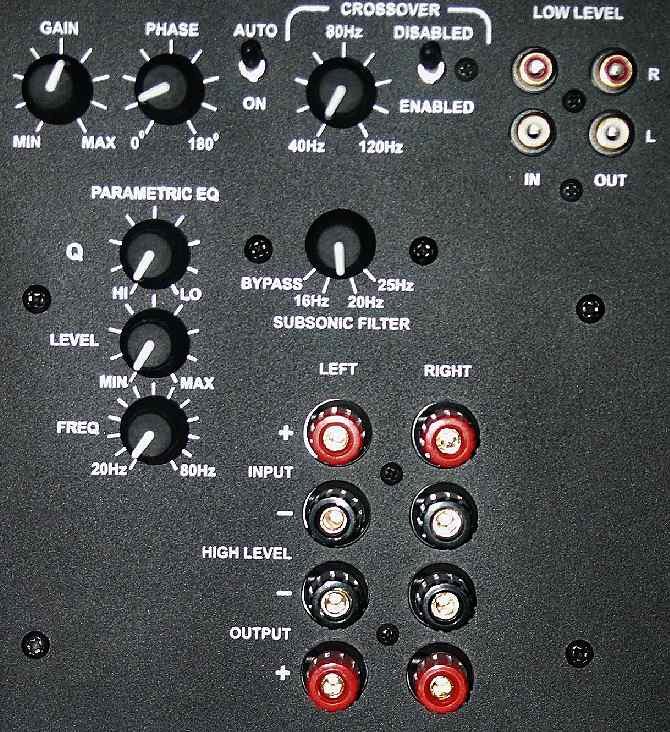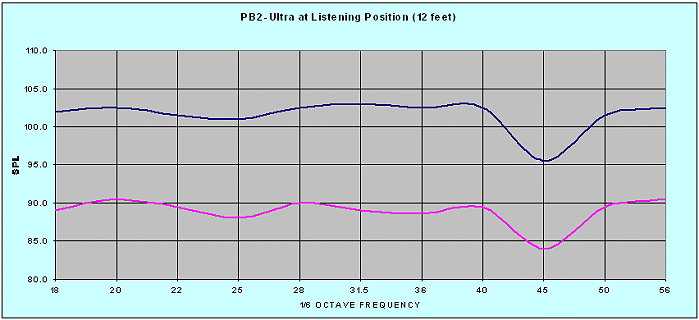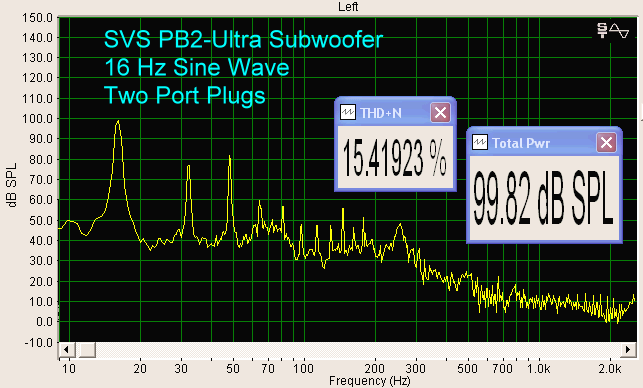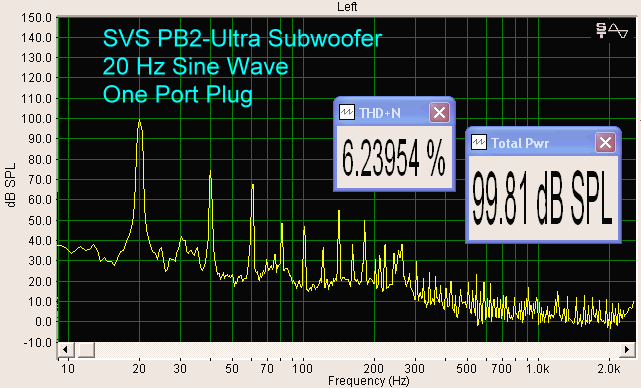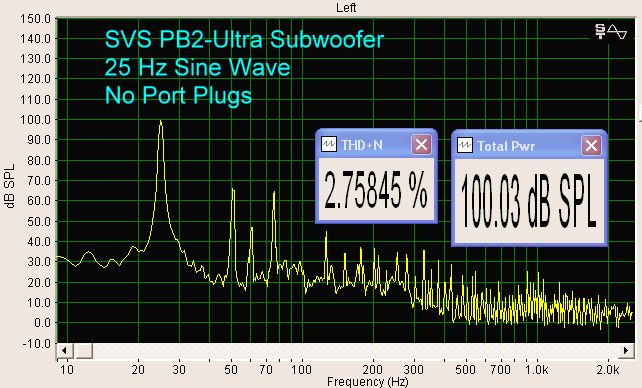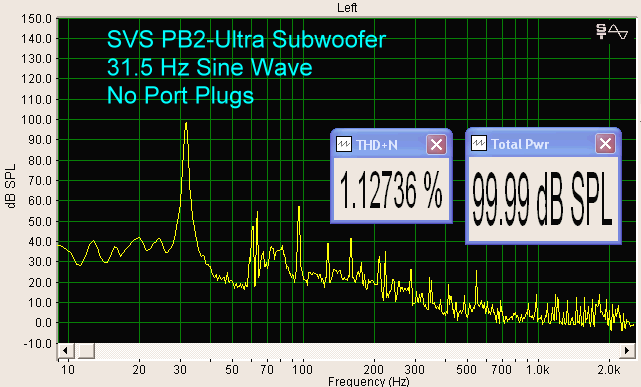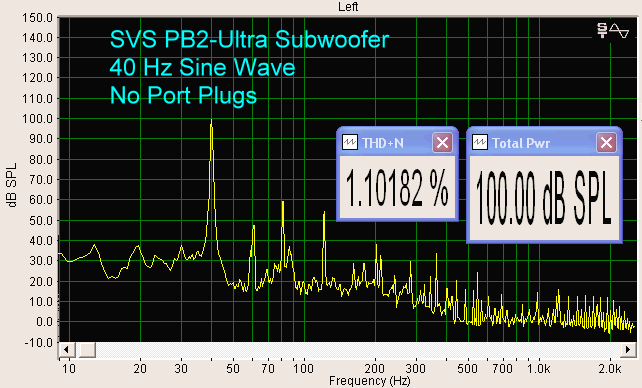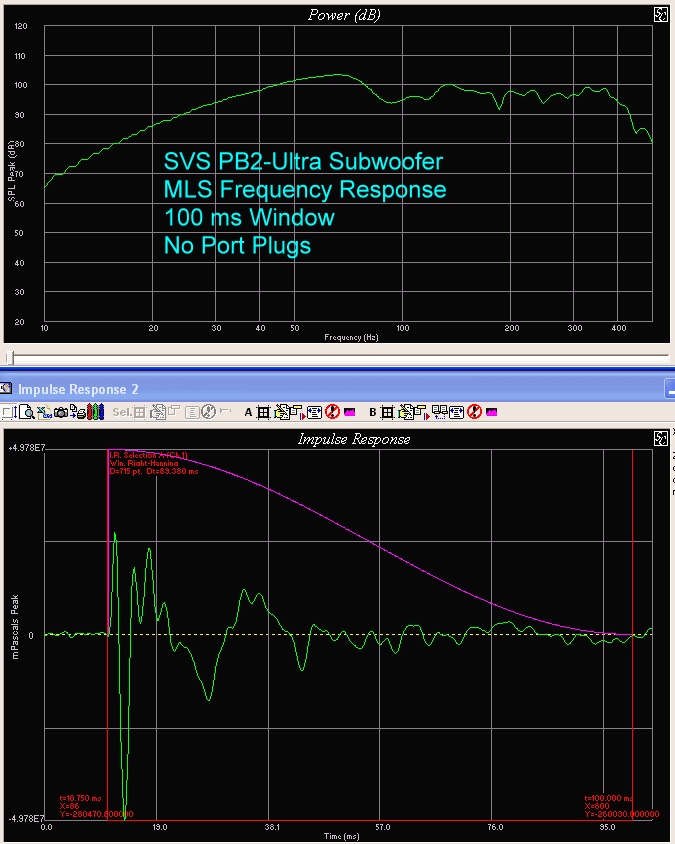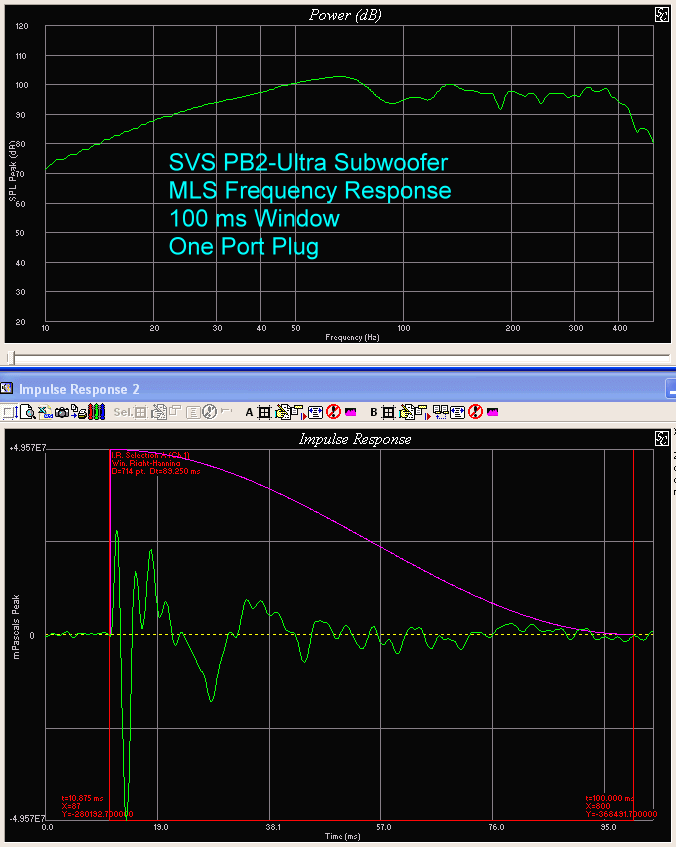|
|||||||||
|
Introduction In early high school, I was a “bass-head”. My car had the nastiest gut-wrenching bass in the parking lot. It was a DIY job, but in my little Honda Civic, the bass was tighter and lower than the other kids' setups, enough to move the rear quarter windows nearly an inch (they would even come unlatched sometimes). After getting my Mechanical Engineering degree, a job, and buying a house, my tastes have changed. I still crave the extreme SPL, but I also want flat frequency response with tight, “musical” bass. I want accuracy, to reproduce exactly what is there in the original recording, regardless of how low or loud it is. I listened to a number of subs in various A/V stores, and everything fell so short of what I wanted, I started to give up hope.
Enter SVS. My friend heard of my plight and said I had to check out his “tube
shaped” SVS PCi. The rest is history, as I bought the PC+ and followed it up
with the PB2-Plus. I had no desire to ever upgrade, the PB2-Plus was such a
phenomenal performer. However, after seeing and hearing a brand spanking new
PB2-Ultra at a former Secrets writer's home, I simply had to test one in my
own home theater! Construction
The cabinet is
made from 1" thick MDF (medium density fiberboard) cut to spec by CNC
machines, then covered with a finished maple veneer, topped with a satin
clear coat. The finished product is truly a beautiful, high quality piece of
furniture. There are also three massive 4" ports, heavily flared on both
ends. The cabinet is unbelievably solid and inert, which it needs to be to
support the pair of impressive TC-Sounds TV-12 “Ultra” woofers. SVS claims
that these are some of the best if not the best 12” woofers available. The
spec sheet certainly seems to back this up, with over 2” of linear travel,
a 97 ounce strontium ferrite magnet, and dual Nomex spiders for starters. As you
will read later, my listening tests proved out that these are indeed special
drivers.
Set-Up Most of the inputs and controls are the same as the PB2-Plus model and include high and low level inputs and outputs, gain control, defeatable crossover with various frequencies, continuously variable phase, power, and auto/always on switches. In addition, there is a subsonic filter knob, with settings of 25 Hz, 20 Hz, 16 Hz, and bypass. These are used with port blocking foam plugs to allow customizing the sub to suit your taste and room. 25 Hz with no plugs will yield the highest overall SPL, while a 16 Hz setting with two plugs will give you some serious bottom trolling extension. It should be noted that in room, at each of the settings, plenty of bass was still apparent below the filter point. Like the PB2-Plus, I settled on one port plug with the 20 Hz subsonic filter setting.
Also included, a first from SVS, is a one-band parametric equalizer (PEQ). The controls allow the user to pick the center frequency, bandwidth, and the desired level of cut wanted. For example, let's say that I check the frequency response and find that I have a peak from 40 to 60 Hz, which at the max point, say 53 Hz, is 6 dB higher than the rest of the curve. To correct this peak, you first turn the “FREQ” knob to the correct hash mark (each one symbolizes 5 Hz), in this case, the 7th one at 50 Hz. Note: this is not the peak freq of 53 Hz, but rather the center between 40 and 60 Hz. Then you adjust the width by turning the “Q” knob. Each hash mark designates 0.1 octave, with a total range from 0.1 to 0.9 octave. To know how much of an octave you need to adjust use the following formula: (Highest Frequency – Center Point)/Center Point. For this example 60 Hz - 50 Hz / 50 Hz = 0.2, the second hash mark. Then adjust the “LEVEL” knob for the amount to cut. Each hash mark corresponds to 1.5 dB of cut, so for this example, the knob would be turned to the 4th hash for 6 dB of cut at the center point.
In many rooms, after moving the sub around to find the
best frequency response, there will still remain one main peak seen across
multiple listening positions, and the one band PEQ on the PB2-Ultra will
work well to tame it. However, after ensuring that the PEQ worked properly, I
switched back to using my Behringer Feedback Destroyer DSP1124P (commonly
known as the BFD). This little tool can be had for a bit over $100 online,
and offers 12 bands of parametric EQ X 2 channels for 24 bands total. I
wanted the extra control because of my limited placement options for the
sub.
The PB2-Ultra was placed in the exact same position, same
tuning, calibrated to the same level and phase set using an 80 Hz test tone
exactly like the PB2-Plus was set. In addition, I used the same EQ settings
on the BFD to minimize room influence the best I could. I used Norah Jones “Come Away with Me” and David Elias “The Window” to check the naturalness of the sound on the acoustic bass. Each was easily handled with no colorations of any kind and sounded just like an acoustic bass was in the room. Of course, much of the tonality of a bass is due to harmonics outside the range of the sub, but if there is a lack of control or colorations with the sub, they are can be very obvious. Next I threw in the music video DVD of Audioslave “Like a Stone”. The PCM track is a different, higher quality mix than the CD version. Tim Commerford's bass work, and Brad Wilk's drums sounded excellent. Even at high volumes (around 100 dB), the bass was extremely tight, and every nuance was conveyed with zero muddiness.
Finally I put in the Queen's The Game DVD-Audio and
checked out “Another One bites the Dust” The complex bass work combined with
a tight kickdrum make for a nice test of a sub's ability to resolve details.
Again, I was left extremely impressed. In all these listening tests, a
single SVS Ultra cylinder would have been sufficient, so even in my large leaky
room, the copious amounts of output the PB2-Ultra is capable of were not
needed. The music tests were more about the quality of the sound than the
raw output, and in this area, the PB2-Ultra excels. I cannot imagine anyone
being disappointed in the sound of this subwoofer. As great a subwoofer as
the PB2-Plus is, the Ultra is in a new league for sound quality. Even at
lower volumes, the ability to separate out complex bass information, as well
as the
weight and clarity of transients, were notably improved. The harder the Ultra
was pushed, the more it shone. The tonal quality was maintained as the
volume was increased. While the PB2-Plus does extremely well, it is simply
outclassed in this area. (Of course, the PB2-Plus is much less expensive.) I love music to no end, but the area that really separates subwoofer performance is the Home Theater environment. With more and more movies calling for large amounts of output in the sub-30 Hz region, you are missing out without a high quality sub. I listened to “Inside the Whale” on Finding Nemo (Chapter 21). All the way to a nearly unbearable –5 dB from reference, the sub was invisible, there could be no clue as to where it was, no overtones, port noise, nothing. There was just wave after wave of pure deep bass. I could feel ripples pass over my body without hearing anything, a sure sign of strong low frequency levels. I could feel my pant legs flapping and the hair on the back of my neck. It wasn't just loud, the PB2-Ultra exhibited perfect tight control. As impressive as that was, Chapter 37, “The Battle of the Pelennor Fields” from Return of the King was breathtaking. I only went to –7 dB from reference because this was as loud as I could stand without ear protection. I could feel the bass everywhere, including inside my windpipe and nasal cavities, then, when the Oliphants fell, it was like a giant hand grabbed the couch and shook it violently.
What is so hard to describe is the
immense power on tap. With the control the Ultra exhibits, it seems like it
is hardly trying. Master and Commander, Toy Story 2, Matrix Revolutions, all
were handled with similar ease. My PB2-Plus did a great job on these same
scenes, but it was different, even though the levels were about the same,
the PB2-Ultra had more weight and clarity. The best I can think to describe
it is that when I pushed the Plus really hard, I could tell when it was near
the limits by hearing it start to strain and lose control. The PB2-Ultra
held onto its tonal character all the way. At low enough levels, nearly any loudspeaker can deliver 20 Hz, even tiny ear-canal headphones. But as the required output rises, subwoofers start dropping by the way side one by one. What I feel really separates the wheat from the chaff is staying flat and linear below 30 Hz, the area where many a small (and even impressive in other areas) cube sub just can't hold up. For this test, I first used the BFD EQ, which was initially set for a flat response using a level of roughly 80 dB. Measurements were taken at 12 feet from the sub at my listening position with a standard analog Radio Shack SPL meter with the correction factors posted on SVS's website among other places. Test tones were played at 1/6th octave intervals from 18 Hz - 56 Hz.
This was exactly the type of response I want to see. Regardless if the PB2-Ultra was required to produce 90 dB or over 100 dB, the frequency response remained nearly identical. What is even more impressive is that these numbers are at 12 feet (4 meters), in an over 3,300 cubic foot room, with multiple doorways. This was nothing short of astounding, with well over 100 dB at 18 Hz without even pushing it at all. I also took some maximum SPL measurements, and I hit over 110 dB at 2 meters @ 20 Hz. On the Bench (JEJ) Our calibrated microphone was placed 12" from the base of the subwoofer. With two port plugs, and the subsonic filter set to 16 Hz, and with the crossover disabled (it was disabled for all the tests), and a 16 Hz sine wave at 100 dB, THD was less than 16%. This may seem like a lot of THD, but it is marvelous performance for 16 Hz. With many subwoofers, THD on the order of 50% or more would be likely at 16 Hz, if you could get it to play at 100 dB output at all.
With one port plug, and the subsonic filter set to 20 Hz, using a 20 Hz sine wave, THD was just over 6%. Again, excellent performance.
Using the PB2-Ultra with no port plugs, the subsonic filter set to 25 Hz, and inputting a 25 Hz sine wave, THD was a very manageable 2.76%.
No port plugs, at 31.5 Hz, THD was now very low.
At 40 Hz, THD was even lower.
And, at 50 Hz, THD was less than 1%. The overall THD picture for the SVS PB2-Ultra is a standard setter for the industry. Every now and then, a product comes along that could be considered reference quality. The SVS PB2-Ultra Subwoofer is one of them.
Below are three quasi-anechoic (MLS technique) frequency response measurements, one with no port plugs, one with a single port plug, and one with two port plugs. You can see that, as I added port plugs, the frequency response flattened out, so that there was a 12 dB drop from 50 Hz to 20 Hz using two port plugs, compared to a 16 dB drop when using no port plugs. The output between 50 Hz and 75 Hz declined with two port plugs, which is what SVS states in their instruction manual. The impulse response shows a positive first wave, indicating the signal is not inverted.
Remember, this is the quasi-anechoic response, not the room response. When I measured maximum SPL output (room response, no MLS filtering), using a combination of 25 Hz, 31.5 Hz, and 40 Hz (I usually employ 20 Hz, 31.5 Hz, and 50 Hz, but for this sub, I had to change the subsonic filter with different port plug combinations, so I used 25 Hz as the lowest frequency for all three configurations), the maximum SPL was not that much different with two plugs vs. none (115 dB vs. 117 dB). This is probably due to room loading. So, I would recommend using the SVS with two port plugs, as this will give you the flattest frequency response, without significant loss in total SPL capability. For single frequencies, with no port plug, I could get 113 dB maximum SPL at 25 Hz, and THD+N was 9%. With one port plug, I could get 113 dB at 7.8% THD+N, and with two port plugs, I could get 114 dB at 14% THD+N.
Note that I always measured the sound with the microphone
placed down by the drivers, even though at certain frequencies, most of the
air was coming out of the ports. This is because I had to change the port
configurations with plugs. Therefore, if anything, the actual THD at those
frequencies where the sound was coming mostly from the port will be lower
than the measured value. I really could not hear any harmonics even with the
PB2-Ultra cranked to high SPL, and it literally took my breath away. It's
one fantastic subwoofer! Giving you this type of performance and cabinet quality at these prices (especially if you get the painted black version), all the while being proudly made in the USA, makes the PB2-Ultra a dynamite product.
A little anecdote best describes how impressive this
subwoofer is. When I first received the PB2-Ultra, I paired it up with my
PB2-Plus, and adjusted the phase and levels to achieve the flattest
response I could. While the bass was still calibrated to the same overall
level as my PB2-Plus alone, the impact was much more visceral, with a heavy
punch me in the gut feeling I hadn't felt outside car audio before.
Listening to several of my favorite bass heavy demos revealed an astounding
clarity, weight, and accuracy. Before leaving for the evening, I put on a
running loop of the first chapter of Toy Story 2 to break the PB2-Ultra in.
I did this while out of the house, and I disconnected my PB2-Plus. A couple
days later I was treating myself to some Monster's, Inc. and Lord of the
Rings: Fellowship of the Ring bass demos. I was astounded at how much
tighter and powerful the bass seemed, with what I thought was the
combination of the two subs. The next evening, I was marveling at the
clear separation in the rotor beats in Blackhawk Down, when I noticed I only
had the PB2-ultra in use! I had forgotten to turn the PB2-Plus back on, and
the bass was impressive enough I didn't even notice! This bit of
absentmindedness really solidified my opinion, the PB2-Ultra is in a class
of its own.
|
|||||||||


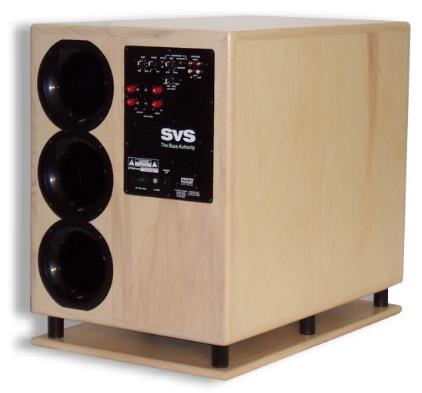 Power is provided by 1,000 watts RMS from the digital
hybrid BASH amplifier.
Power is provided by 1,000 watts RMS from the digital
hybrid BASH amplifier.